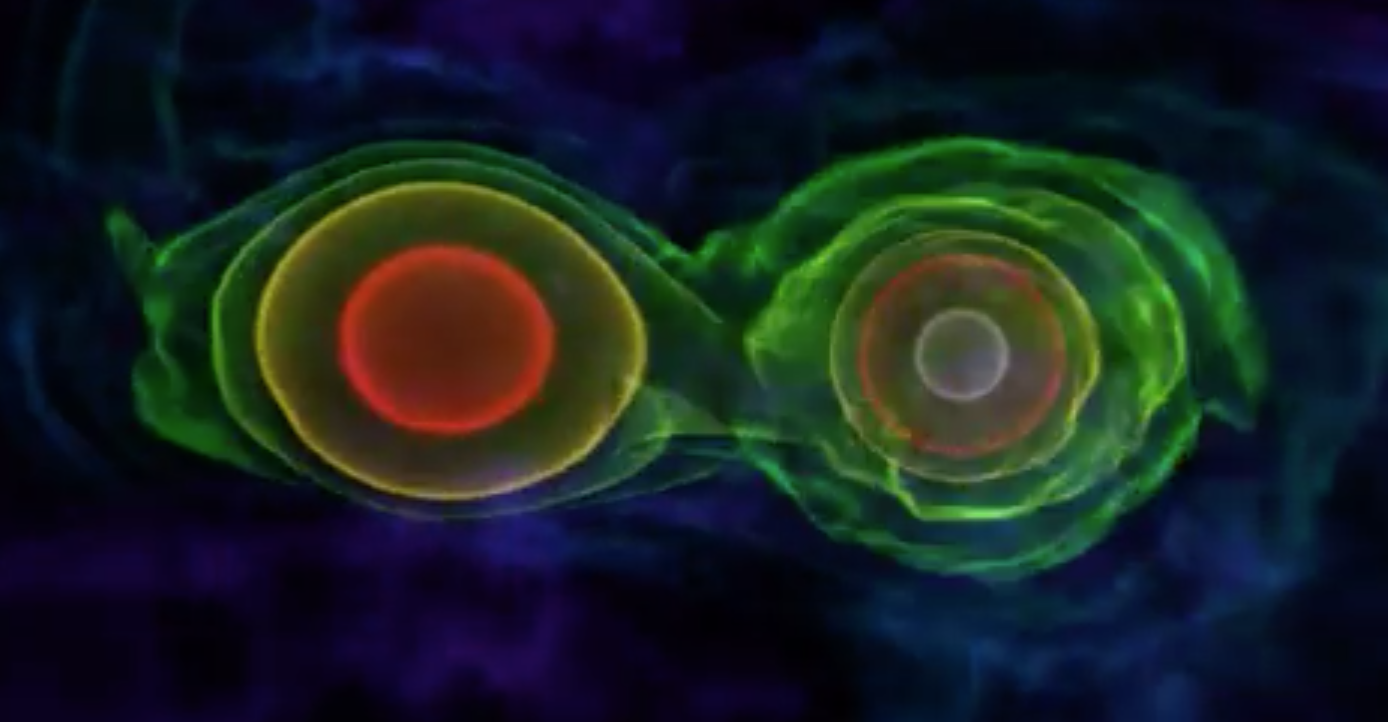The spectacular Supernova 1987A, whose light reached Earth on Feb. 23 of the year it’s named for, captured the public’s fancy. It’s located at the edge of the Milky Way, in a dwarf galaxy called the Large Magellanic Cloud. It had been four centuries since earthlings had witnessed light from a star exploding in our galaxy.
A supernova’s awesome light show heralds a giant star’s death, and the next supernova’s post-mortem will generate reams of data, compared to the paltry dozen or so neutrinos and X-rays harvested from the 1987 event.
Astrophysicists Michael Zingale and Bronson Messer aren’t waiting. They’re aggressively anticipating the next supernova by leading teams in high-performance computer simulations of explosive stellar events, including different supernova types and their accompanying X-ray bursts. Zingale, of Stony Brook University, and Messer, of the Department of Energy’s Oak Ridge National Laboratory (ORNL), are in the midst of an award from the DOE Office of Science’s Innovative and Novel Computational Impact on Theory and Experiment (INCITE) program. It provides an allocation of 45 million processor hours of computer time on Titan, a Cray XK7 that’s one of the world’s most powerful supercomputers, at the Oak Ridge Leadership Computing Facility, or OLCF – a DOE Office of Science user facility.
The simulations run on workhorse codes developed by the INCITE collaborators and at the DOE’s Lawrence Berkeley National Laboratory – codes that “are often modified toward specific problems,” Zingale says. “And the common problem we share with ORNL is that we have to put more and more of our algorithms on the Titan graphics processor units (GPUs),” specialized computer chips that accelerate calculations. While the phenomena they’re modeling “are really far away and on scales that are hard to imagine,” the codes have other applications closer to home: “terrestrial phenomena, like terrestrial combustion.” The team’s codes – Maestro, Castro, Chimera and FLASH – are available to other modelers free through online code repository Github.
With a previous INCITE award, the researchers realized the possibility of attacking the GPU problem together. They envisioned codes comprised of multiphysics modules that compute common pieces of most kinds of explosive activities, Messer says. They dubbed the growing collection of GPU-enabled modules Starkiller.
“Starkiller ties this INCITE project together,” he says. “We realized we didn’t want to reinvent the wheel with each new simulation.” For example, a module that tracks nuclear burning helps the researchers create larger networks for nucleosynthesis, a supernova process in which elements form in the turbulent flow on the stellar surface.
As the white dwarf grows in mass, it gets hotter and denser in the center, creating conditions that drive thermonuclear reactions.
“In the past, we were able to do only a little more than a dozen different elements, and now we’re routinely doing 150,” Messer says. “We can make the GPU run so much faster. That’s part of Titan’s advantage to us.”
Supernova 1987A, a type II supernova, arose from the gravitational collapse of a stellar core, the consistent fate of massive stars. Type Ia supernovae follow from intense thermonuclear activities that eventually drive the explosion of a white dwarf – a star that has used up all its hydrogen. Zingale’s group is focused on type Ia, Messer’s on type II. A type II leaves a remnant star; a type Ia does not.
Stars like the sun burn hydrogen into helium and, over enormous stretches of time, burn the helium into carbon. Once our sun starts burning carbon, it will gradually peter out, Messer says, because it’s not massive enough to turn the carbon into something heavier.
“A star begins life as a big ball of hydrogen, and its whole life is this fight between gravity trying to suck it into the middle and thermonuclear reactions keeping it supported against its own gravity,” he adds. “Once it gets to the point where it’s burning some carbon, the sun will just give up. It will blow a big smoke ring into space and become a planetary nebula, and at the center it will become a white dwarf.”
Zingale is modeling two distinct thermonuclear modes. One is for a white dwarf in a binary system – two stars orbiting one another – that consumes additional material from its partner. As the white dwarf grows in mass, it gets hotter and denser in the center, creating conditions that drive thermonuclear reactions.
“This star is made mostly of carbon and oxygen,” Zingale says. “When you get up to a few hundred million K, you have densities of a few billion grams per cubic centimeter. Carbon nuclei get fused and make things like neon and sodium and magnesium, and the star gets energy out in that process. We are modeling the star’s convection, the creation of a rippling burning front that converts the carbon and oxygen into heavier elements such as iron and nickel. This creates such an enormous amount of energy that it overcomes the force of gravity that’s holding the star together, and the whole thing blows apart.”
The other mode is being modeled with former Stony Brook graduate student and INCITE co-principal investigator Max Katz, who want to understand whether merging stars can create a burning point that leads to a supernova, as some observations suggest. His simulations feature two white dwarfs so close that they emit gravitational radiation, robbing energy from the system and causing the stars to spiral inward. Eventually, they get so close that the more massive one rips the lesser apart via tidal energy.
Zingale’s group also continues to model the convective burning on stars, known as X-ray bursts, providing a springboard to more in-depth studies. He says they’re the first to simulate them in three dimensions. That work and additional supernova studies were supported by the DOE Office of Science and performed at OLCF and the National Energy Research Scientific Computing Center, a DOE Office of Science user facility at Lawrence Berkeley National Laboratory.
